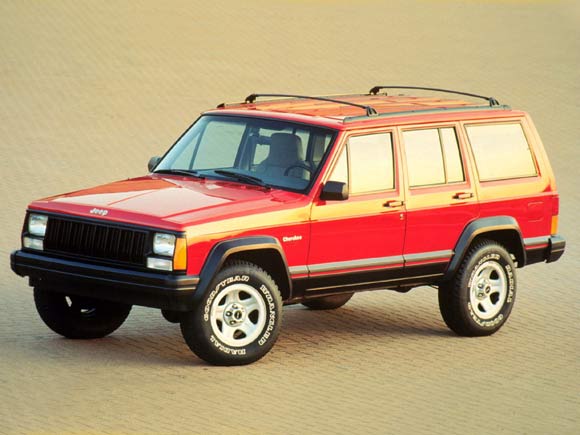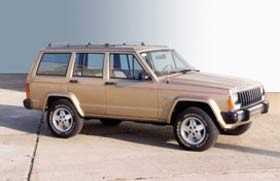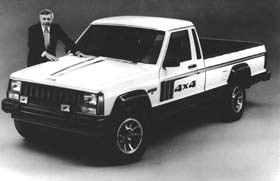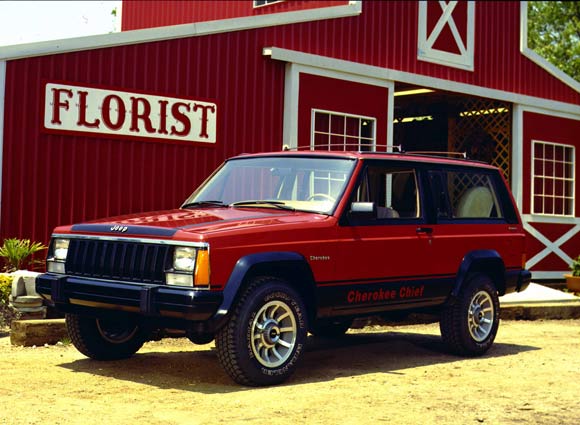Jeep XJ Cherokee - Click above for high-res image gallery
It's easy to deride American Motors Corporation as mediocre to the point of failure. Legions of fans will argue vehemently that the last independent was a nimble innovator that consistently outflanked the competition with creative, clever products. In fact, the final vestiges of the company have just been worn away by the sands of the current decade, even though Chrysler hungrily swallowed up AMC for its Jeep property in 1987.
Jeep's value is undeniable. Just as it was the crown jewel in AMC's portfolio, it's likely the most valuable asset Chrysler has right now, too. There's been further depth to the Jeep line virtually since the beginning, with offerings like the Willys Jeep Wagon, Jeepster, Cherokee/Wagoneer, and J-series pickups expanding options for buyers. While those vehicles all trended toward larger, more deluxe offerings, one Jeep vehicle helped start a movement that's still with us.
The Jeep Cherokee, designated the XJ, was a deft move in the early 1980s, and was a major factor in making SUVs the modern family car over the last 15 years. In the late 1970s, plans got underway at AMC for a new Jeep vehicle, one that shared only the Cherokee name with its older SJ sibling. The chiseled styling was so handsome and well-balanced that Jeep's current Patriot and Liberty are still aping it in an attempt to close sales. Two- and four-door models made up the initial offering, joined shortly thereafter by the shorter-lived Comanche pickup.

Fitting in the lineup between the CJs and the much larger Wagoneers, both classics in their own right, the Cherokee was just the right size in 1984. The Cherokee's arrival on the market coincided with Ford's introduction of the Bronco II, and Toyota's rolling out of its 4Runner. Just a year prior, General Motors launched its S10/S15 Blazer/Jimmy twins, and Nissan would chime in with its Pathfinder in 1986. Competition in the segment was less fierce, and there were fewer choices, but the Cherokee was considered by many to be the standard bearer.


Consumers flocked toward these newly debuted SUVs as a replacement for the family wagon. Manageable size made the Cherokee as easy to maneuver as a car, and it did so while packing serious off-road prowess. Most of the engineering for the Cherokee's running gear had been worked out in earlier AMC vehicles like the Concord and Spirit; sedans and wagons which carrying transfer cases up their sleeves. In the swaths of the country that experience winter weather, the Cherokee was a safe haven from tail-wagging family trucksters, able to surefootedly press on in nasty conditions. Heading off road, as very few original XJ buyers did, was another revelation. The Cherokee is a billy goat.
Engines were the largest stumbling block for the early Cherokees. AMC's own 2.5-liter four-cylinder was present, and an optional GM-sourced 2.8-liter V6 was also available for a bit more oomph. Neither motor set the Cherokee back on its heels with accelerative force, and it wasn't until the arrival of the revered 4.0-liter inline-six in 1987 that there was finally adequate grunt from the engine room. Interestingly, a Renault turbodiesel was also offered early on, between 1985 and 1987. Today, they are as rare as hen's teeth and a perfect candidate for a greasecar conversion.

AMC became newly chic with the Cherokee as troublesome European wagons were traded in for this broad-shouldered progeny of Toledo. The ride and handling had an edge of Jeepyness, feeling stiff-kneed, and exhibiting some mild head toss, but buyers found the tradeoffs acceptable and Jeep was smart enough to dress up the XJ in a few ways to entice customers, too. The Wagoneer name migrated down to the XJ, and those were trimmed more luxuriously. Wagoneer and Wagoneer Limiteds have four headlamps, and there's also the classical woodgrain applique on the flanks of the Limited models. The interior design is a product of its time, though it is clean and straightforward. Legroom wasn't gigantic in any seating position, but overall, the Cherokee accommodated four people happily, five with a little grumbling.
Detail changes abound throughout the Cherokee's nearly twenty year run from 1984-2001. 1997 brought revised styling with a softened nose and retrimmed rear hatch and taillights. Older examples are more likely to have some rust, and the age of the bodyshell's design may make the structure more susceptible to rot than more modern efforts. The XJ's winter prowess probably makes it more challenging to find one that hasn't tasted road salt, but there are still good Cherokees to be found.
_280.jpg)
_280.jpg)
The running gear, whether it's the four-cylinder, the inline-six, or even GM's V6, will not be hard to find parts and pieces for, although some powertrain combinations are more desirable than others. Watch out for the 2.8-liter mill and Peugeot gearboxes. The unit body with integrated ladder frame reinforcement was also further stiffened for the '97 update, but all Cherokees go down the road with a solid confidence, especially when there's a torquey 4.0 underhood. There were two variants of four-wheel drive systems - Command-Trac and Selec-Trac, and all versions used Quadra-Link front suspension. The chassis is a little trucky, but it's quite well behaved for the class, especially considering its capabilities.
Other markets have known the joy of the Cherokee. European XJs were available with a VM Motori diesel, and a commercial version was also made with metal in place of the rear side windows, like a sedan-delivery. China, too, has had the Cherokee move in. AMC had blazed the trail with automotive partnerships in China, and Beijing Jeep kept the XJ alive as the Jeep 2500 until 2006, 19 years after AMC disappeared from the face of the planet – impressive legs for a company that always had to do more with less while competing on the big stage with better funded Detroit competition.
_580.jpg)
_580.jpg)

Sign in to post
Please sign in to leave a comment.
Continue